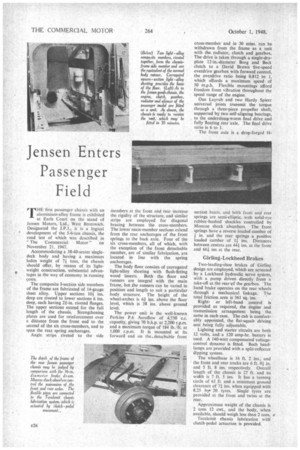Jensen Enters Passenger Field
Page 152

If you've noticed an error in this article please click here to report it so we can fix it.
THE first passenger chassis with an aluminium-alloy frame is exhibited at Earls Court on the stand of Jensen Motors, Ltd., West Bromwich. Designated the J.P.I., it is a logical
• development of the 5-6-ton chassis, the road test of which was described in "The Commercial Motor" on November 21, 1947.
Accommodating a 38-40-seater singledeck body and having a maximum laden weight of 7i tons, the chassis should offer, by reason of its lightweight construction, substantial advantages in the way of economy in running costs.
The composite I-section side members of the frame are fabricated of 14-gauge sheet alloy. Upper sections 10i ins. deep are riveted to lower sections 6 ins. deep, each having 24-in. riveted flanges. The upper sections extend for the full length of the chassis. Strengthening plates are used for reinforcement over a distance from the front end to the second of the six cross-members, and to span the rear spring anchorages.
Angle strips riveted to the side
members at the front and rear increase the rigidity of the structure, and similar strips are employed for diagonal bracing between the cross-members. The lower main-member sections extend from the rear anchorages of the front springs to the back axle, Four of the six cross-members, all of which, with the exception of the front detachable member, are of similar fabrication, are located in line with the spring anchorages.
The body floor consists of corrugated light-alloy sheeting with flush-fitting wood inserts. Both the floor and runners are integral with the main frame, but The runners can be varied in position and length to suit a particular body structure. The height of the wheel-arches is 61 ins, above the floor level, which is 38 ins, above ground level.
The power unit is the well-known Perkins P.6 Aeroflow of 4,730 c.c. capacity, giving 70 b.h.p. at 2,200 r.p.m, and a maximum torque of 184 lb./ft. at 1,000 r.p.m. It is mounted at its forward end on the-detachable front cross-member and in 30 mins. can be withdrawn from the frame as a unit with the. radiator, clutch and gearbox. The drive is taken through a single-dryplate 12-in.-diameter Borg and Beck clutch to a David Brown five-speed overdrive gearbox with forward control, the overdrive ratio being 0.812 to I. which affords a maximum speed of 50 m.p.h. Flexible mountings afford freedom from vibration throughout the speed range of the engine, One Layrub and two Hardy Spicer universal joints transmit the torque through a three-piece propeller shaft, supported by two self-aligning bearings, to the underslung-worm final drive and fully floating rear axle. The final drive ratio is 6 to 1.
The front axle is a drop-forged H
section beam, and both front and war springs are semi-elliptic, with solid-eye rubber-bushed shackles controlled by Monroe shock absorbers. The front *springs have a reverse loaded camber of
in. and the rear springs a positive loaded camber of 1 ins. Distances between centres are 441 ins, at the front and 66i ins at the rear.
Girling-Lockheed Brakes
Two-leading-shoe brakes of Girling design are employed, which are actuated by a Lockheed hydraulic servo system, with a pump driven directly from a take-off at the rearef the gearbox. The hand brake operates on the rear wheels through a mechanical linkage. The total friction area is 361 sq. ins.
'Rightor left-hand control is provided as required, the engine and transmission arrangement being the same in each case. The cab is comfortably appointed, the flat-squab driving seat being fully adjustable.
Lighting and starter circuits arc both 12 volts, and a 120' amp-hr. battery is used. A 140-watt compensated voltagecontrol dynamo is fitted. Both headlamps are provided with a split-reflector dipping system.
The wheelbase is 16 ft. 2 ins., and the front and rear tracks are 6 ft. Oi in. and 5 ft. 8 ins. respectively. Overall length of the chassis is 27 ft. and its width is 7 ft. 5 ins. It has a turning circle of 61 ft. and a minimum ground clearance of 7.1 ins, when equipped with 8,25 by. 20 tyres. Single tyres are provided at the front and twins at the rear.
Approximate weight of the chassis is 2 tons 12 cwt., and the body, when available, should weigh less than 2 tons. •
Tecalemit chassis lubrication with clutch-pedal actuation is provided.












































































































































































































































